
Warragamba Dam is a heritage-listed dam in the outer South Western Sydney suburb of Warragamba, Wollondilly Shire in New South Wales, Australia. It is a concrete gravity dam, which creates Lake Burragorang, the primary reservoir for water supply for the city of Sydney. The dam wall is located approximately 65 kilometres (40 mi) W of Sydney central business district, 4½ km SW of the town of Wallacia, and 1 km NW of the village of Warragamba.

Lake Burragorang is a man-made reservoir in the lower Blue Mountains of New South Wales, Australia, serving as a major water supply for greater metropolitan Sydney. The dam impounding the lake, the Warragamba Dam, is located approximately 60 kilometres (37 mi) southwest of the Sydney central business district.
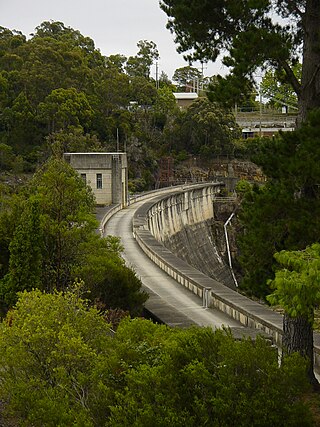
The Nepean Dam is a heritage-listed dam split across Avon in the Wingecarribee Shire and Bargo in the Wollondilly Shire, both in New South Wales, Australia. The reservoir created by the dam spreads across Avon, Bargo and also Yerrinbool in Wingecarribee Shire. The Nepean Dam is one of four dams and weirs in the catchment of the Upper Nepean Scheme, in New South Wales, Australia, and provides water to the Macarthur and Illawarra regions, the Wollondilly Shire, and metropolitan Sydney. Completed in 1935 under the supervision of Ernest Macartney de Burgh, the dam is currently managed by the Sydney Catchment Authority and is listed on the New South Wales State Heritage Register.

The Woronora Dam is a heritage-listed concrete gravity dam with an uncontrolled serpentine spillway across the Woronora River, located south of Greater Metropolitan Sydney, in the suburb of Woronora Dam, Sutherland Shire, New South Wales, Australia. The principal purpose of the dam is for potable water supply for Sydney's southern suburbs and the northern suburbs of the Illawarra region. The impounded 71,790-megalitre reservoir is also called Woronora Dam and is sometimes incorrectly called Lake Woronora. The dam was designed by G. E. Haskins, Chief Engineer and the Metropolitan Water, Sewerage and Drainage Board of NSW (MWS&DB) and built from 1927 to 1941 by the MWS&DB. The property is owned by the Sydney Catchment Authority, an agency of the Government of New South Wales. It was added to the New South Wales State Heritage Register on 18 November 1999.
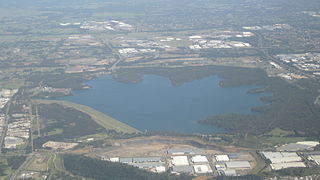
The Prospect Reservoir is a heritage-listed 50,200-megalitre potable water supply and storage reservoir created by the Prospect Dam, across the Prospect Creek located in the Western Sydney suburb of Prospect, in New South Wales, Australia. The eastern bounds of the reservoir are a recreational area and the western periphery are within the bounds of Western Sydney Parklands. It was added to the New South Wales State Heritage Register on 18 November 1999.

Walka Water Works is a heritage-listed 19th-century pumping station at 55 Scobies Lane, Oakhampton Heights, City of Maitland, New South Wales, Australia. Originally built in 1887 to supply water to Newcastle and the lower Hunter Valley, it has since been restored and preserved and is part of Maitland City Council's Walka Recreation and Wildlife Reserve. It was added to the New South Wales State Heritage Register on 2 April 1999.
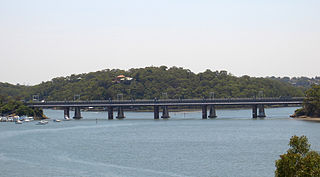
The Como railway bridge carries the Illawarra railway line across the Georges River between the Sydney suburbs of Oatley and Como.

Bankstown Reservoir is a heritage-protected water tower and a local landmark situated in the suburb of Bankstown, Sydney, New South Wales, Australia. Located 22 kilometres (14 mi) west of Sydney CBD, the reservoir is elevated and was built on reinforced concrete piers, which is one of the oldest of this type that is still in use. The reservoir features various decorative attributes, plastered by hand, which lack in other functional reservoirs. Established in 1920, the reservoir serves a large area of South-Western Sydney.

Lewisham Sewage Aqueduct is a heritage-listed sewage aqueduct in Gadigal Reserve, adjacent to 5 Grosvenor Crescent, Summer Hill, Inner West Council, Sydney, New South Wales, Australia. It was designed by Sewerage Construction Branch and Department of Public Works and built in 1900. The property is owned by Sydney Water. It was added to the New South Wales State Heritage Register on 18 November 1999.

Potts Hill Reservoirs 1 and 2 are heritage-listed reservoirs at Cooper Road, Potts Hill, City of Canterbury-Bankstown, New South Wales, Australia. It was designed by Board of Water Supply and Sewerage and built from 1880. The reservoirs are now maintained by the Board's successor, Sydney Water. It was added to the New South Wales State Heritage Register on 18 November 1999.

Drummoyne Reservoir is a heritage-listed decommissioned elevated service reservoir at Rawson Avenue, Drummoyne, City of Canada Bay, New South Wales, Australia. It was designed by engineer J. G. S. Purvis from the Metropolitan Board of Water Supply and Sewerage and built from 1910 to 1913, with the Board responsible for the construction of the substructure and Poole & Steele Ltd responsible for the tank manufacture. It is also known as WS0038 and Drummoyne Elevated Steel Reservoir. It was added to the New South Wales State Heritage Register on 15 November 2002. Sydney Water sold the property in September 2018 to owners of a chain of childcare centres, who plan to convert the site into a childcare centre while retaining most of the heritage structure.

The Waverley Reservoirs are four reservoirs, of which two are heritage-listed, located at Paul Street, Bondi Junction, Waverley Municipality, New South Wales, Australia. They were designed and built by the Public Works Department. The property is owned by Sydney Water, an agency of the Government of New South Wales. The properties were added to the New South Wales State Heritage Register on 18 November 1999 and 15 November 2002 respectively.

The Old Como railway bridge is a heritage-listed former railway bridge and now footbridge and water main carrier over the Georges River between Como and Oatley in the Sutherland Shire Council and Georges River Council local government areas of New South Wales, Australia. It was designed by John Whitton and Dept of Railways and built from 1883 to 1885 by C. and E. Millar. The property is owned by Sydney Water, an agency of the Government of New South Wales. It was added to the New South Wales State Heritage Register on 15 November 2002.

The Guildford West pipehead and water supply canal is a heritage-listed sewerage infrastructure and water supply canal located at Frank Street, Guildford in the Cumberland Council local government area of New South Wales, Australia. It is also known as Headworks; Industrial Archaeological Site. The property is owned by Sydney Water, an agency of the Government of New South Wales. It was added to the New South Wales State Heritage Register on 15 November 2002.

The Ashfield Reservoir is a heritage-listed reservoir located at Holden Street, Ashbury, City of Canterbury-Bankstown, New South Wales, Australia. It was designed and built by the Metropolitan Board of Water Supply and Sewerage. It is also known as Ashfield Reservoir (Elevated) and WS 0003. The property is owned by Sydney Water. It was added to the New South Wales State Heritage Register on 15 November 2002.

The Ryde Pumping Station is a heritage-listed pumping station and offices located at Victoria Road, West Ryde, New South Wales, Australia. It was built from 1891 to 1921 by William Adams & Co. Ltd., State Monier Works, Refshaw & O'Brien. It is also known as Ryde Pumping Station and site, WP005 and West Ryde Pumping Station. The property is owned by Sydney Water. It was added to the New South Wales State Heritage Register on 15 November 2002.

Chatswood Reservoirs No. 1 and No. 2 are two heritage-listed reservoirs located at 559 Pacific Highway in the Sydney suburb of Artarmon in the City of Willoughby local government area of New South Wales, Australia. They were designed and built by the NSW Public Works Department. They are also known as WS024 & WS025 respectively. The reservoirs are owned by Sydney Water, a State-owned statutory corporation of the Government of New South Wales. The reservoirs were added to the New South Wales State Heritage Register on 18 November 1999.
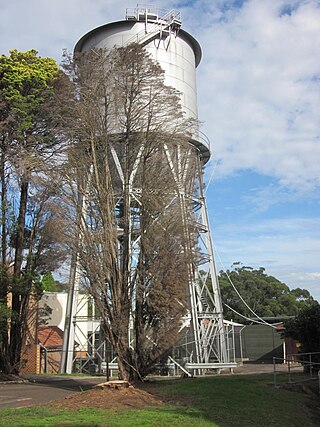
The Wahroonga Reservoir is a heritage-listed reservoir located at 1678 Pacific Highway and Woonona Avenue in the Sydney suburb of Wahroonga in the Ku-ring-gai Council local government area of New South Wales, Australia. It was designed and built by the Metropolitan Board of Water Supply and Sewerage in 1915. It is also known as Wahroonga Reservoir (Elevated) . The property is owned by Sydney Water, a State-owned statutory corporation of the Government of New South Wales. It was added to the New South Wales State Heritage Register on 18 November 1999.

The Pymble Reservoirs No. 1 and No. 2 are two heritage-listed reservoirs located at Pacific Highway in the Sydney suburb of Pymble in the Ku-ring-gai Council local government area of New South Wales, Australia. The reservoirs are also known as Pymble Reservoir No. 1 (Covered) and (WS 0097); and Pymble Reservoir No. 2 (Covered) and (WS 0098). The property is owned by Sydney Water, a State-owned statutory corporation of the Government of New South Wales. The reservoirs were added to the New South Wales State Heritage Register on 15 November 2002.
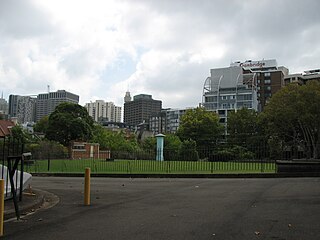
The Crown Street Reservoir is a heritage-listed reservoir located at 285 Crown Street, Surry Hills, City of Sydney, New South Wales, Australia. It was built by Donohoe and Vaughan. It is also known as Crown Street Reservoir & Site and WS 0034. The property is owned by Sydney Water, an agency of the Government of New South Wales. It was added to the New South Wales State Heritage Register on 18 November 1999.






















